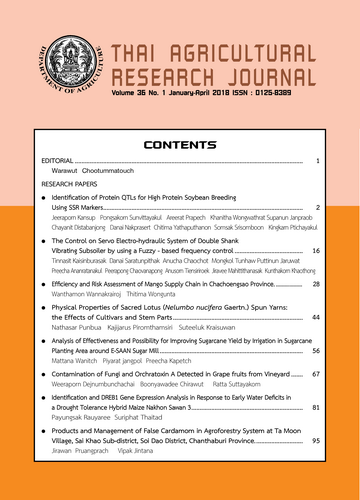Identification of Protein QTLs for High Protein Soybean Breeding Using SSR Markers
DOI:
https://doi.org/10.14456/thaidoa-agres.2018.9Keywords:
soybean (Glycine max (L.) Merr.), seed protein content, quantitative trait loci (QTL), simple sequence repeat (SSR) markersAbstract
The objective of this study was to identify quantitative trait loci (QTL) governing soybean protein content using simple sequence repeat (SSR) markers which linked to the protein’s character. The SSR markers were used in soybean breeding to select high protein varieties rapidly and accurately. A population of 4 recombinant inbred lines (RILs) deriving from crosses between Thai soybean varieties with different seed protein contents (C5-2, C42-3 as female parents and S1-3, S17-3 as male parents) was used to QTL analyzes. DNA from the parents was screened with 218 SSR markers and 106 markers showed polymorphisms in the parents. The polymorphic markers were used in genotyping to find out cross-pollinated F1 plants. The segregation in F2 generation was confirmed by observation of pubescence color with 3:1 ratio which brown pubescence was controlled by a single dominant gene. To generate F3 – F7 of RILs, single seed descent method was used. One hundred and six markers, which showed polymorphisms in the parents, were used to identify QTL associated with soybean protein content. PCR results from F7 RIL population and percent protein content in F8 seeds were assembled to use in QTLs analysis. Four QTLs for protein content were localized Satt184, Satt590, Satt196 and Satt247. The information related to these markers will be very useful for breeding process of high protein soybean and also to find novel candidate genes which are important to protein content in soybean seed of Thai soybean varieties.
Downloads
Published
How to Cite
Issue
Section
License

This work is licensed under a Creative Commons Attribution-NonCommercial-NoDerivatives 4.0 International License.
Thai Agricultural Research Journal



